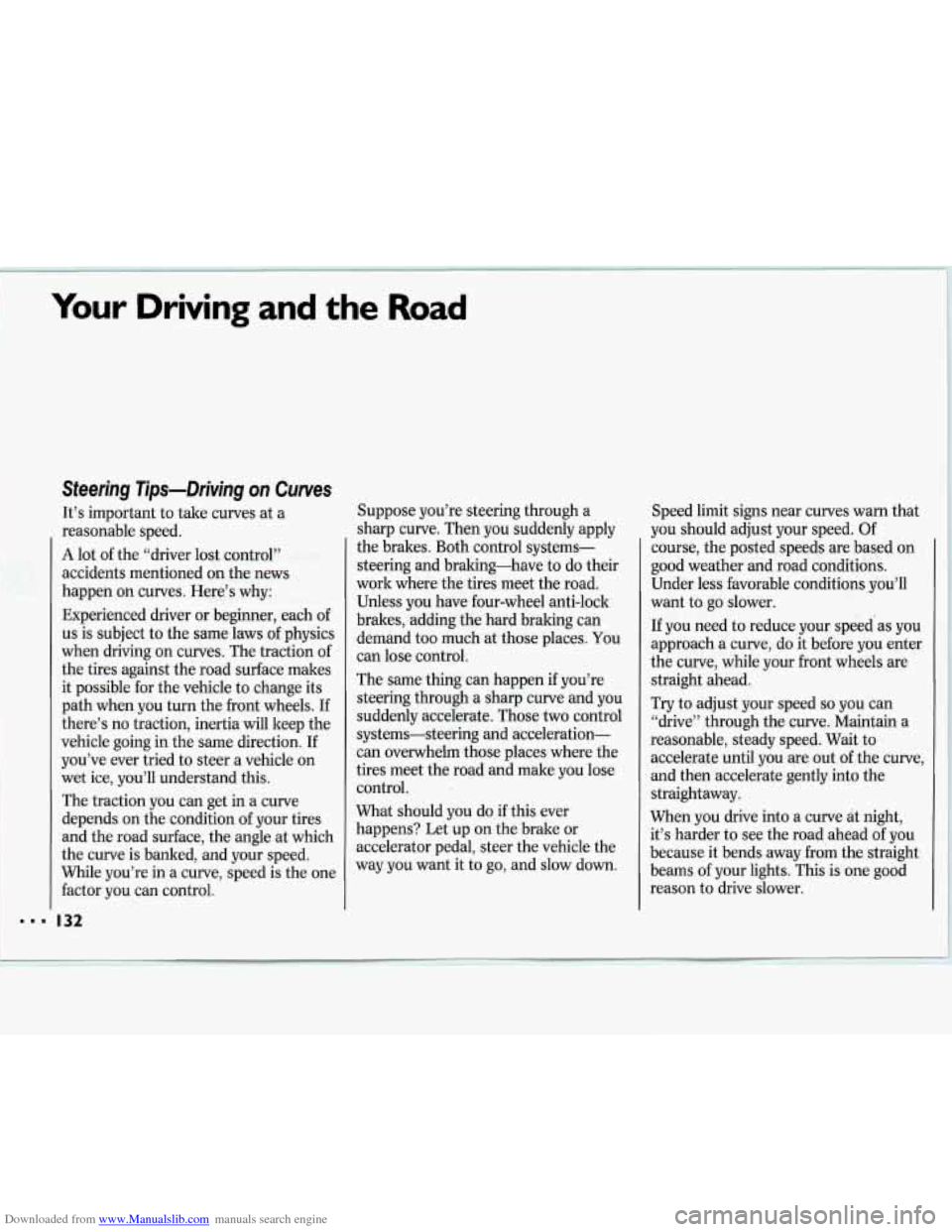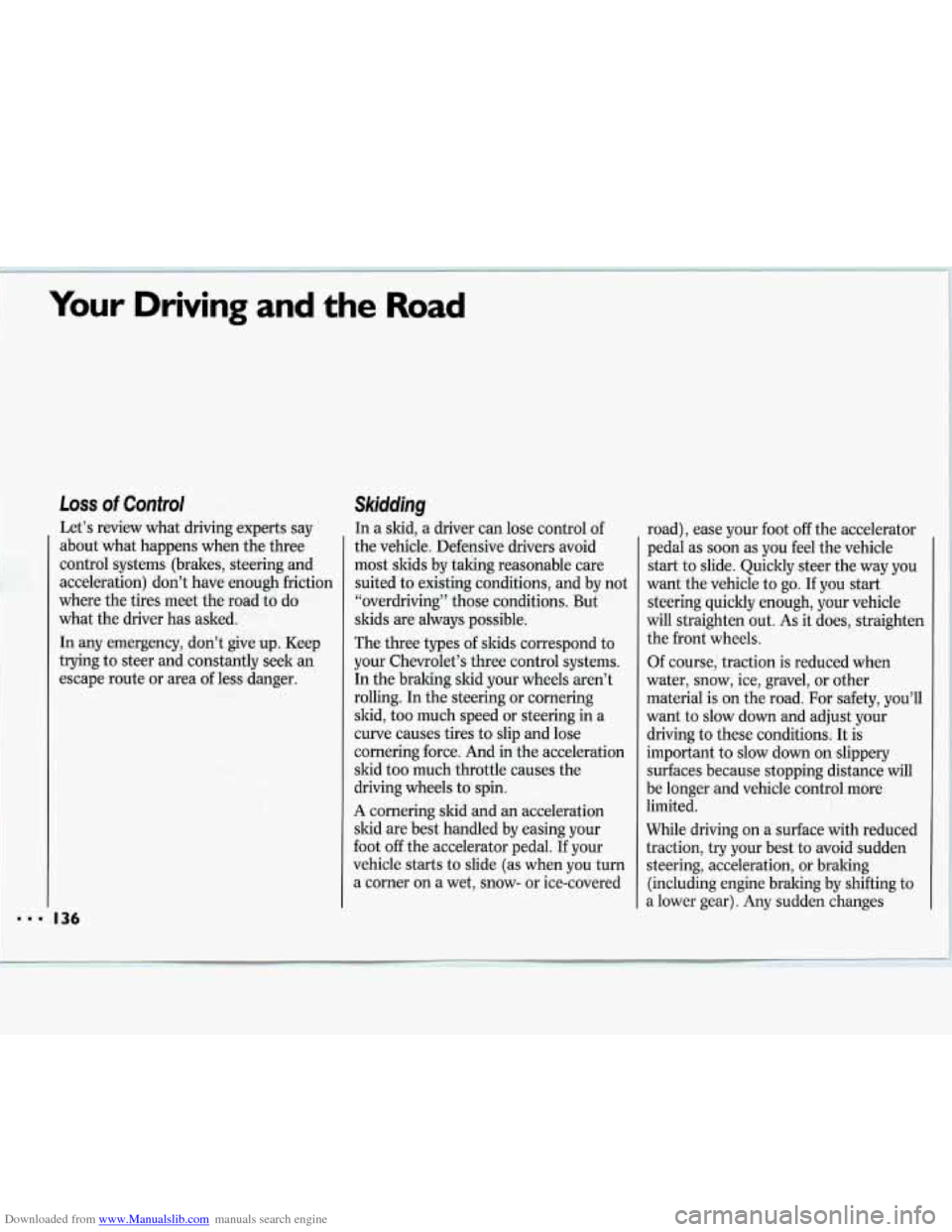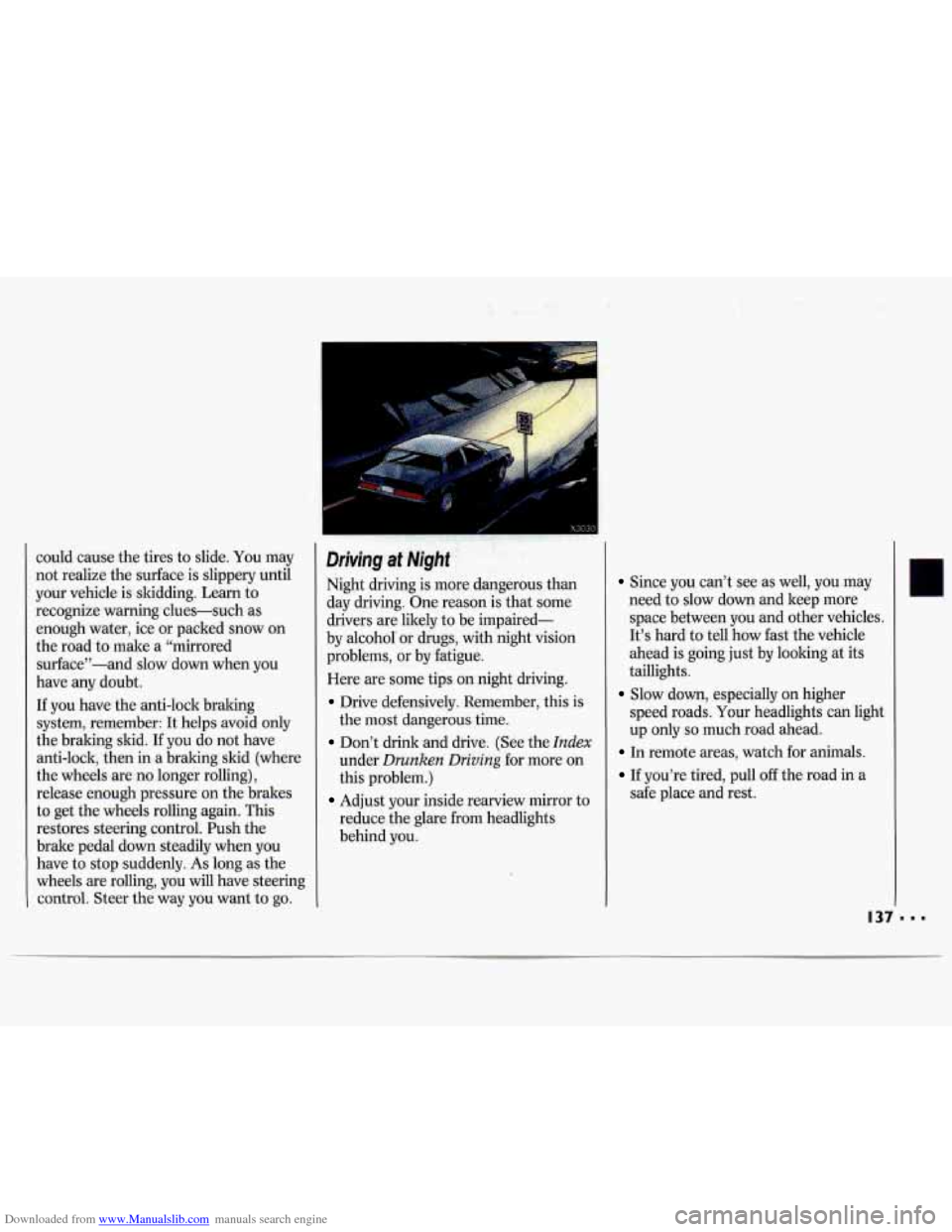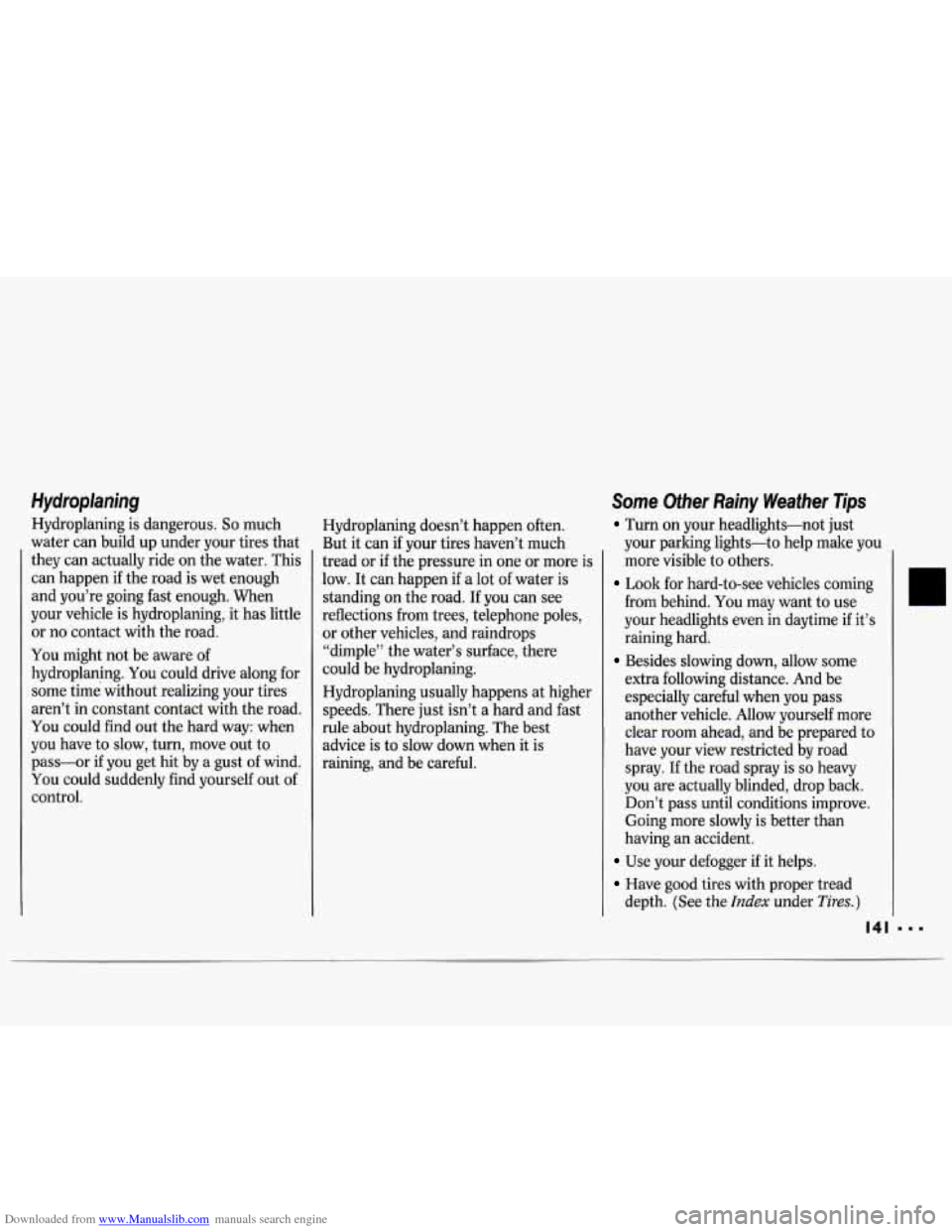1993 CHEVROLET LUMINA tires
[x] Cancel search: tiresPage 127 of 324

Downloaded from www.Manualslib.com manuals search engine I
“I’ll be careful” isn’t the right answer.
What if there’s an emergency, a need to
take sudden action, as when a child
darts into the street?
A person with a
higher
BAC might not be able to react
quickly enough to avoid the collision.
There’s something else about drinking
and driving that many people don’t
know. Medical research shows that
alcohol in a person’s system can make
crash injuries worse. That’s especially
true for brain, spinal cord and heart
injuries. That means that if anyone who
has been drinking-driver or
passenger-is in a crash, the chance of
being killed or permanently disabled is
higher than if that person had not been
drinking. And we’ve already seen that the
chance
of a crash itself is higher for
drinking drivers.
Control of a Vehicle
You have three systems that make your
vehicle go where you want it to go.
They are the brakes, the steering and
the accelerator.
All three systems have
to do their work at the places where the
tires meet the road.
Sometimes, as when you’re driving on
snow or ice, it’s easy to ask more of
those control systems than the tires and
road can provide. That means you can
lose control of your vehicle.
Page 134 of 324

Downloaded from www.Manualslib.com manuals search engine Your Driving and the Road
Steering Tips-Driving on Curves
It’s important to take curves at a
reasonable speed.
A lot of the “driver lost control”
accidents mentioned
on the news
happen
on curves. Here’s why:
Experienced driver or beginner, each of
us is subject to the same laws of physics
when driving
on curves. The traction of
the tires against the road surface makes
it possible for the vehicle to change its
path when you turn the front wheels. If
there’s
no traction, inertia will keep the
vehicle going in the same direction. If
you’ve ever tried to steer a vehicle
on
wet ice, you’ll understand this.
The traction you can get in a curve
depends
on the condition of your tires
and the road surface, the angle at which
the curve is banked, and your speed.
While you’re in a curve, speed is the one
factor you can control. Suppose you’re steering through a
sharp curve. Then you suddenly apply
the brakes. Both control systems-
steering and braking-have to do their
work where the tires meet the road.
Unless you have four-wheel anti-lock
brakes, adding the hard braking can
demand too much at those places. You
can lose control.
The same thing can happen if you’re
steering through a sharp curve and you
suddenly accelerate. Those two control
systems-steering and acceleration-
can overwhelm those places where the
tires meet the road and make you lose
control.
What should you do if this ever
happens? Let up
on the brake or
accelerator pedal, steer the vehicle the
way you want it to go, and slow down. Speed limit signs near curves warn
that
you should adjust your speed. Of
course, the posted speeds are based
on
good weather and road conditions.
Under less favorable conditions you’ll
want to go slower.
If you need to reduce your speed’as you
approach a curve, do it before you enter
the curve, while your front wheels are
straight ahead.
Try to adjust your speed
so you can
“drive” through the curve. Maintain a
reasonable, steady speed. Wait to
accelerate until you are out of the curve,
and then accelerate gently into the
straightaway.
When you drive into a curve
at night,
it’s harder to see the road ahead of you
because it bends away from the straight
beams of your lights. This is one good
reason to drive slower.
132
Page 138 of 324

Downloaded from www.Manualslib.com manuals search engine Your Driving and the Road
Loss of Control
Let’s review what driving experts say
about what happens when the three
control systems (brakes, steering and
acceleration) don’t have enough friction
where the tires meet the road to do
what the driver has asked.
In any emergency, don’t give up. Keep
trying to steer and constantly seek an
escape route or area of less danger.
136
Skidding
In a skid, a driver can lose control of
the vehicle. Defensive drivers avoid
most skids by taking reasonable care
suited to existing conditions, and by not
“overdriving” those conditions. But
skids are always possible.
The three types
of skids correspond to
your Chevrolet’s three control systems. In the braking skid your wheels aren’t
rolling. In the steering or cornering
skid, too much speed or steering in a
curve causes tires to slip and lose
cornering force. And in the acceleration
skid too much throttle causes the
driving wheels to spin.
A cornering skid and an acceleration
skid are best handled by easing your
foot
off the accelerator pedal. If your
vehicle starts to slide (as when you turn
a corner on a wet, snow- or ice-covered road),
ease your foot
off the accelerator
pedal as soon as you feel the vehicle
start to slide. Quickly steer the way you
want the vehicle to go. If you start
steering quickly enough, your vehicle
will straighten out.
As it does, straighten
the front wheels.
Of course, traction is reduced when
I 1
water, snow, ice, gravel, or other
material is on the road. For safety, you’ll
I I
want to slow down and adjust your
driving to these conditions. It is
important to slow down
on slippery
surfaces because stopping distance will
be longer and vehicle control more
limited.
While driving
on a surface with reduced
traction, try your best to avoid sudden
steering, acceleration, or braking
(including engine braking by shifting to
a lower gear).
Any sudden changes
Page 139 of 324

Downloaded from www.Manualslib.com manuals search engine -.,.. -
could cause the tires to slide. You may
not realize the surface is slippery until
your vehicle is skidding. Learn to
recognize warning clues-such as
enough water, ice or packed snow on
the road to make a “mirrored
surface”-and slow down when you
have any doubt.
If you have the anti-lock braking
system, remember: It helps avoid only
the braking
skid. If you do not have
anti-lock, then
in a braking skid (where
the wheels are no longer rohg),
release enough pressure on the brakes
to get the wheels rolling again.
This
restores steering control. Push the
brake pedal down steadily when
you
have to stop suddenly. As long as the
wheels are rolling, you will have steering
control. Steer the way you want to
go.
-
X3030 , , -;. - ., ,
Driving. at Might
Night driving is more dangerous than
day driving. One reason is that some
drivers are likely to be impaired-
by alcohol or drugs, with night vision
problems,
or by fatigue.
Here are some tips on night driving.
Drive defensively. Remember, this is
the most dangerous time.
Don’t drink and drive. (See the Index
under Drunken Driving for more on
this problem.)
Adjust your inside rearview mirror to
reduce the glare from headlights
behind you.
Since you can’t see as well, you may
need to slow
down and keep more
space between you
and other vehicles.
It’s hard to tell how fast the vehicle
ahead’is going just by looking at its
taillights.
Slow down, esp.ecially on higher
speed roads. Your headlights can light
up only so much road ahead.
In remote areas, watch for animals.
If you’re tired, pull off the road in a
safe place and rest.
Page 141 of 324

Downloaded from www.Manualslib.com manuals search engine Remember that your headlights light up
far less of
a roadway when you are in a
turn or curve.
Keep your eyes moving; that way, it’s
easier to pick out dimly li@ted objects.
Just as
your headlights should be
checked regularly for proper aim,
so
should your eyes be examined regularly. Some drivers suffer
from night
blindness-the inability to see in dim
light-and aren’t even aware
of it. Rain and
wet roads can mean driving
trouble.
Qn a wet road.you can’t stop,
accelerate or turn
as well because your
tire-to-road traction isn’t as good
as on
dry roads. And, ifyour tires don’t have
much tread lea, you’ll get even less
traction.
It’s always wise to go slower and be
cautious
if rain starts to fall while you
are driving. The surface may get wet
suddenly when your reflexes are tuned
for driving on dry pavement.
The heavier the rain, the harder it is to
see. Even
if your windshield wiper
blades are in good shape, a heavy rain
can make it harder to
see road signs and
traffic signals, pavement markings, the
edge of the road, and even people
Page 143 of 324

Downloaded from www.Manualslib.com manuals search engine Hydroplaning
Hydroplaning is dangerous. So much
water can build up under your tires that
they can actually ride on the water. This
can happen if the road is wet enough
and you’re going fast enough. When
your vehicle is hydroplaning, it has little
or no contact with the road.
You might not be aware of
hydroplaning.
You could drive along for
some time without realizing your tires
aren’t in constant contact with the road.
You could find out the hard way: when
you have to slow, turn, move out to
pass--or if you get hit by
a gust of wind.
You could suddenly find yourself out of
control. Hydroplaning doesn’t happen often.
But
it can
if your tires haven’t much
tread or if the pressure in one or more is
low. It can happen if a lot of water is
standing on the road. If you can see
reflections from trees, telephone poles, or other vehicles, and raindrops
“dimple” the water’s surface, there
could be hydroplaning.
Hydroplaning usually happens at higher
speeds. There just isn’t a hard and fast
rule about hydroplaning. The best
advice is to slow down when it
is
raining, and be careful.
Some Other Rainy Weather Tips
Turn on your headlights-not just
your parking lights-to help make you
more visible to others.
Look for hard-to-see vehicles coming
from behind.
You may want to use
your headlights even in daytime if it’s
raining hard.
Besides slowing down, allow some
extra following distance. And be
especially careful when you pass
another vehicle. Allow yourself more
clear room ahead, and be prepared to
have your view restricted by road
spray. If the road spray is
so heavy
you are actually blinded, drop back.
Don’t pass until conditions improve.
Going more slowly is better than
having an accident.
Use your defogger if it helps.
Have good tires with proper tread
depth. (See the
Index under Tires.)
Page 148 of 324

Downloaded from www.Manualslib.com manuals search engine Your Driving and the Road
‘I
Driving a long Distance
Although most long trips today are
made on freeways, there are still many
made on regular highways.
Long-distance driving on freeways and
regular highways is the same in some
ways. The trip has to be planned and
the vehicle prepared, you drive at
higher-than-city speeds, and there are
longer turns behind the wheel. You’ll
enjoy your trip more if you and your
vehicle are in good shape. Here are
some tips for a successful long trip.
I46
Before leaving on a Long Trip
Make sure you’re ready. Try to be well
rested. If you must start when you’re
not fresh-such as after a day’s work-
don’t plan to make too many miles that
first part
of the journey. Wear
comfortable clothing and shoes you can
easily drive in.
Is your vehicle ready for a long trip?
If
you keep it serviced and maintained, it’s
ready to go. If it needs service, have it
done before starting out. Of course,
you’ll find experienced and able service
experts in Chevrolet dealerships all
across North America. They’ll be ready
and willing to help
if you need it. Here
are some things you can check
before a trip:
Windshield Washer Fluid: Is the
reservoir full? Are all windows clean
inside and outside?
shape?
Have you checked all levels?
lenses clean?
Wiper Blades: Are they in good
Fuel, Engine Oil, Other Fluids:
Lights: Are they all working? Are the I
Tires: They are vitally important to a I
safe, trouble-free trip. Is the tread
good enough for long-distance
driving? Are the tires all inflated to
the recommended pressure?
weather outlook along your route? Should you delay your trip a short
time to avoid a major storm system?
Maps: Do you have up-to-date maps?
Weather Forecasts: What’s the
Page 149 of 324

Downloaded from www.Manualslib.com manuals search engine On the Road
Unless you are the only driver, it is good
to share the driving task with others.
Limit turns behind the wheel to about
100 miles (160 km) or two hours at a
sitting. Then, either change drivers or
stop for some refreshment like coffee,
tea or soft drinlts and some limbering
up. But do stop and move around. Eat
lightly along the way. Heavier meals
tend to make some people sleepy.
On two-lane highways or undivided
multilane highways that do not have
controlled access, you’ll want to watch
for some situations not usually found
on freeways. Examples are: stop signs
and signals, shopping centers with
direct access to the highway, no passing
zones and school zones, vehicles
turning left and right off the road,
pedestrians, cyclists, parked vehicles, and even animals.
Highway Hypnosis
Is there actually such a condition as
“highway hypnosis”? Or is it just plain
falling asleep at the wheel? Call it
highway hypnosis, lack of awareness, or
whatever.
There is something about an easy
stretch of road with the same scenery,
along with the hum of the tires on the
road, the drone of the engine, and the
rush of the wind against the vehicle that
can make you sleepy. Don’t let it
happen to you! If it does, your vehicle
can leave the road in
less than a second,
and you could crash and be injured.
What can you do about highway
hypnosis? First, be aware that it can
happen.
Then here are some tips:
Make sure your vehicle is well
ventilated, with a comfortably cool interior.
Keep your eyes moving. Scan the road
ahead and to the sides. Check your
rearview mirrors frequently and your
instruments from time to time. This
can help you avoid a fixed stare.
Wear good sunglasses in bright light.
Glare can cause drowsiness. But don’t
wear sunglasses at night. They will
drastically reduce your overall vision
at the very time you need all the
seeing power you have.
If you get sleepy, pull off the road into
a rest, service, or parking area and
take a nap, get some exercise, or both.
For safety, treat drowsiness on the
highway as an emergency.
As in any driving situation, keep pace
with traffic and allow adequate
following distances.